#thalattosuchia
Explore tagged Tumblr posts
Text

Metriorhynchids were a group of fully marine crocodyliforms known from the mid-Jurassic to the early Cretaceous of Europe and the Americas. They were the most aquatic-adapted of all known archosaurs, with streamlined bodies, smooth scaleless skin, small front flippers, larger hind flippers, and shark-like tail flukes. They may also have been endothermic, and might even have given live birth at sea rather than laying eggs.
Rhacheosaurus gracilis here was a metriorhynchid that lived in warm shallow waters around what is now Germany during the late Jurassic, about 150 million years ago. Around 1.5m long (~5'), its long narrow snout lined with delicate pointed teeth suggests it fed on small soft-bodied prey, a niche partitioning specialization that allowed it to coexist with several other metriorhynchid species in the same habitat.
Unlike most other marine reptiles metriorhynchids didn't have particularly retracted nostrils, which may have had a limiting effect on their efficiency as sustained swimmers since higher-set nostrils make it much easier to breathe without having to lift the whole head above the surface. The lack of such an adaptation in this group may be due to their ancestors having a single nasal opening formed entirely within the premaxilla bones at the tip of the snout, uniquely limiting how far it could easily shift backwards – other marine reptiles had nostrils bound by the edges of multiple different bones, giving them much more flexibility to move the openings around.
(By the early Cretaceous a close relative of Rhacheosaurus did actually evolve nostrils bound by both the premaxilla and the maxilla, and appeared to have started more significant retraction, but unfortunately this only happened shortly before the group's extinction.)
Metriorhynchids also had well-developed salt glands in front of their eyes, but the large sinuses that accommodated these glands may have made their skulls ill-suited to deep diving, being more susceptible to serious damage from pressure changes and restricting their swimming to near-surface waters only.
Preserved skin impressions in some metriorhynchid fossils show several unusual "irregularities", including curl shapes, small bumps, and cratering. It's unknown what exactly caused these marks, but they may represent scarring from external parasites such as lampreys and barnacles.
———
NixIllustration.com | Tumblr | Patreon
References:
Andrade, Marco BD, and Mark T. Young. "High diversity of thalattosuchian crocodylians and the niche partition in the Solnhofen Sea." 56th Symposium of Vertebrate Palaeontology and Comparative Anatomy, 2008. https://svpca.org/years/2008_dublin/abstracts.pdf#page=14
Séon, Nicolas, et al. "Thermophysiologies of Jurassic marine crocodylomorphs inferred from the oxygen isotope composition of their tooth apatite." Philosophical Transactions of the Royal Society B 375.1793 (2020): 20190139. https://doi.org/10.1098/rstb.2019.0139
Spindler, Frederik. "Live Birth in a Jurassic Marine Crocodile." Abstracts of the 90th Annual Meeting of the Paläontologische Gesellschaft, 2019. https://www.palaeontologie.geowissenschaften.uni-muenchen.de/pdfs/palges2019_abstracts.pdf#page=141
Spindler, Frederik, et al. "The integument of pelagic crocodylomorphs (Thalattosuchia: Metriorhynchidae)" Palaeontologia Electronica 24.2 (2021): a25. https://doi.org/10.26879/1099
Young, Mark T., et al. "Convergent evolution and possible constraint in the posterodorsal retraction of the external nares in pelagic crocodylomorphs." Zoological Journal of the Linnean Society 189.2 (2020): 494-520. https://doi.org/10.1093/zoolinnean/zlaa021
Young, Mark T., et al. "Skull sinuses precluded extinct crocodile relatives from cetacean-style deep diving as they transitioned from land to sea." Royal Society Open Science 11.10 (2024): 241272. https://doi.org/10.1098/rsos.241272
Wikipedia contributors. “Metriorhynchidae” Wikipedia, 12 Nov. 2024, https://en.wikipedia.org/wiki/Metriorhynchidae
Wikipedia contributors. “Rhacheosaurus” Wikipedia, 02 Dec. 2024, https://en.wikipedia.org/wiki/Rhacheosaurus
#science illustration#paleontology#paleoart#palaeoblr#rhacheosaurus#metriorhynchidae#thalattosuchia#crocodyliformes#crocodylomorpha#pseudosuchia#archosaur#art#marine reptile#lamprey#barnacle#parasite
546 notes
·
View notes
Text
Croc Paleontology Recap January 2025
The year has just begun and already we got a bunch of pretty neat new studies on fossil pseudosuchians so I'll just briefly go over them and unless I forget or end up procrastinating/getting too busy I'll hopefully be able to keep this going throughout the rest of the year.
Just to give you a brief overview, the highlights of this month include: salt glands in gavialoids, crocodilian predation on azhdarchids, diversifications and extinctions in thalattosuchians and a new species of aetoaur from India. Lets begin.
Evidence for salt glands in gavialoids
Starting off with something relating to the dispersal of gavialoids, we got "Evaluation of the endocranial anatomy of the early Paleogene north African gavialoid crocodylian Argochampsa krebsi and evolutionary implications for adaptation to salinity tolerance in marine crocodyliforms" by Pliggersdorfer, Burke and Mannion.
The title already gives a lot away, but the point was that Argochampsa, from the early Paleocene Ouled Abdoun Basin in Morocco, was examined for evidence of salt tolerance. Why? Because the dispersal of gavialoids remains weird. Both modern forms aren't especially keen on saltwater and are only known to consistently occur in freshwater (tho we have a recent example of an indian gharial caught in a fishing net off the coast of India), yet we have plenty of extinct gavialoids that either indicate that the group must have crossed oceans (see any "gryposuchine") or straight up lived at sea (also see some "gryposuchines").
Now, one such example might also be Argochampsa. Both because the Ouled Abdoul Basin famously preserves coastal deposits and because, at least following some phylogenies, Argochampsa might be closely related to the gharials of South America and today (others say its not even a gavialoid but lets ignore that for now). So all things considered one might expect marine habits from Argochampsa, yet so far no such adaptations could be identified. Well, Pliggersdorfer and co. analyzed a thus-far undescribed skull and actually managed to find something. Small depressions on the inside of the skull are suspiciously similar to ones seen in the extinct, fully marine metriorhynchoids, depressions that in the latter have been interpreted as having been left by salt glands. There is also some further evidence through the morphology of the inner ear.
This conclusion further extends to a handfull of other taxa, including the dyrosaurid Rhabdognathus and the recently named gavialoid Sutekhsuchus, and lends itself to the hypothesis that salt glands may have been ancestral to gavialoids, something I personally find unsurprising given their proximity to crocodyloids and their dispersal across the world (really if anything alligatoroids seem like the odd one out).
Fun fact, yours truly is featured in the paper in the form of two silhouettes.
Left: Argochampsa, illustrated by Seismic Shrimp/JW Right: Piscogavialis, perhaps the most famous marine gavialoid, illustrated by Joschua Knüppe


The brain of Paralligator
Second on our neat little list, the neuroanatomy of Paralligator, studied through CT scans and 3D modeling and published on in "Neurocranial anatomy of Paralligator (Neosuchia: Paralligatoridae) from the Upper Cretaceous of Mongolia". Given that I am not great with brain things, I'll keep this one short.
Now for those unfamiliar, Paralligator is part of a somewhat strange clade known as the Paralligatoridae, which contrary to their name are nowhere near real alligators (tho some do look deceptively similar). Instead, they are much more basal members of Eusuchia.
Measurements of the olfactory bulbs, responsible for the sense of smell, indicate that in Paralligator this sense was similarily developed to allodaposuchids and crocodilians, as is the inner ear who's anatomy suggests a semi-aquatic lifestyle. Paralligator does however differ in possessing a mesothemoid, a bony septum in the olfactory region that is also seen in dyrosaurids, baurusuchids and dinosaurs, but not modern crocodiles.

Borealosuchus remains from Colorado
Tho seemingly unexciting, this study, "First record of Borealosuchus sternbergii from thelower Paleocene Denver Formation (lower Danian),Colorado (Denver Basin)" actually helps us fill a neat little gap in our previous knowledge on croc survival across the Cretaceous-Paleocene extinction.
Simply put, though America's croc record across the KPG is rather remarkable, showing both many survivors and some incredible diversification after the impact, Colorado is kind of a blind spot, despite its potential importance. Perhaps one of the best examples of a survivor concerns the genus Borealosuchus, which is both geographically and stratigraphically widespread. To put things into perspective, this genus occured as far north as Canada and as far south as Texas, first appearing in the Late Cretaceous and dying out in the Eocene.
This paper now described several skulls from the Corall Bluff's locality of the Denver Formation, earliest Paleocene, that can be attributed to Borealosuchus sternbergii, definitively extending its range beyond KPG (granted, there are tentatively referred Paleocene occurences elsewhere), making it one of the largest suvivors of the mass extinction, with adults growing up to 2.3 meter in length. The specimens from Colorado are smaller, in the 1.5 to 1.7 meter range, but they are also regarded as immature individuals and are therefore also regarded as usefull in illustrating how the animals changed as they grew into adulthood.
This paper is especially well timed for those that follow @knuppitalism-with-ue 's Formation Stream series. As you might know, Corall Bluffs is to be drawn barely a week from now and this is a fantastic addition.
Left: Borealosuchus drawn by Atak_Draws Right: Distribution of Borealosuchus by Lessner, Petermann and Lyson 2025

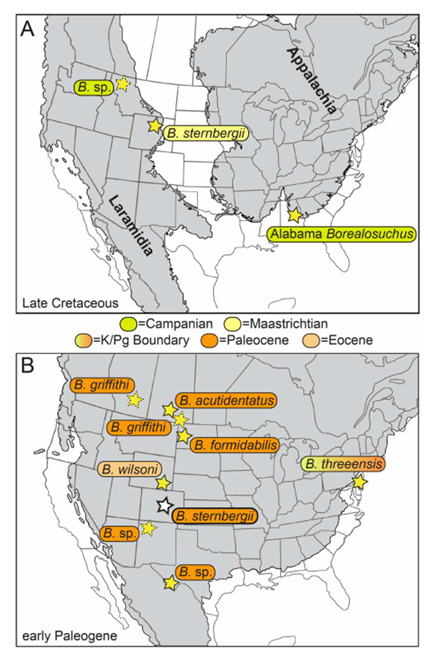
Growth of a peirosaur
Our next paper for discussion is "Life history and growth dynamics of a peirosaurid crocodylomorph (Mesoeucrocodylia; Notosuchia) from the Late Cretaceous of Argentina inferred from its bone histology" by Tamara G. Navarro and colleagues. This study conducted the first histology of peirosaurid limb bones, specifically of an indetermined taxon clading together with Uberabasuchus.
As a brief refresher, peirosaurids are a branch of medium to large sized Notosuchians that I personally think can be aptly described as appearing somewhat like scaly dogs or pigs with often robust, wedge-shaped heads and heavily armored bodies.
The results show that the animal had reached sexual maturity, yet was not yet fully grown. What's also noted is the exact growth dynamics of this animal. This is to say, the studied peirosaurid had overall slow growth with cycles of no growth whatsoever and two periods of increased growth, tho once put against other notosuchians the study deems the growth rates to be better described as "moderate". Pepesuchus meanwhile, belonging to the closely related itasuchids, was a fast grower. Extending things beyond their shared clade shows a virtual mish-mash of dynamics, with Araripesuchus buitreraensis displaying slow growth rates (yet Araripesuchus wegeneri having faster rates than the peirosaur), Iberosuchus showing slow rates, and Notosuchus displaying high growth rates (hell, theres even variation between individuals). A final point concerns the age of the individual, which is....contradictory. Based on the limb bones, the study estimates that the animal was at the very least 15 years old, but previous study of the osteoderms has yielded an estimated age of 18 years old. Ultimately, further study is needed, but it does clearly show how the histology of different parts of the skeleton varies.
Shown below, Uberabasuchus terrificus by Scott Reid

Predation on pterosaurs
Here's a fun one, "A juvenile pterosaur vertebra with putative crocodilian bite from the Campanian of Alberta, Canada", once again with a name that tells you very much what you're in for.
Brown and colleagues report on the discovery of a juvenile specimen of the azhdarchid Cryodrakon from the Dinosaur Park Formation of Alberta, Canada. The neck vertebra bears some conical bite marks, notably different from those of theropods, which generally have D-shaped or compressed tooth crosssections (sans spinosaurids, which aren't present). Champsosaurus is also ruled out due to its inferred feeding preferences, weak bite force and slender teeth. Mammals are potential candidates, but the team regards it as more likely that the trace maker was a crocodilian. Considering the fauna of the Dinosaur Park Formation, this would suggest the culprit was either Leidyosuchus, Albertochampsa or an animal described as "Stangerochampsa-like".
Now this is a very interesting, if not exactly unexpected interaction. On the one hand, having direct fossil evidence for this is a big deal, even if we don't know if the bite marks were left due to the pterosaur being actively hunted or if they were simply left when a lucky croc came across the carcass of an already deceased Cryodrakon. On the other hand, crocodiles and kin are notoriously opportunistic and broad in their diet, so one feeding on a pterosaur is something that seems like a no-brainer in principle, especially a relatively small individual with a wingspan of "only" 2 meters. This is further supported by the fact that crocodilian bite marks have also been reported from the Romanian pterosaur Eurazhdarcho.
Obvious difference in prey size and geography aside (and taxon names even within the chosen setting while we're on it), Prehistoric Planet really nailed the nailon the head with this one.
In the left corner, a juvenile Cryodrakton (art by Hank Sharpe). In the right corner, Leidyosuchus (art by Gunnar Bivens) LET THEM FIGHT (or scavenge)
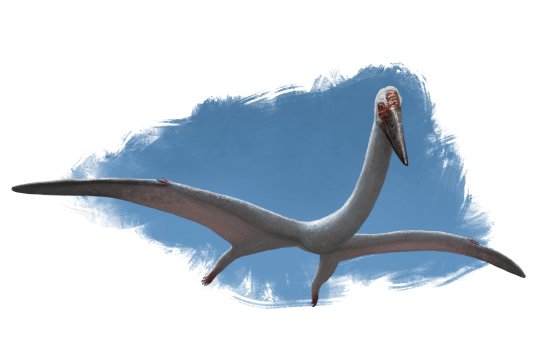

Evolutionary trends and extinctions in Thalattosuchia
This one's a last minute entry, by which I mean this one got just published as I was about to wrap this whole thing up. "Analysing Thalattosuchia palaeobiodiversity through the prism of phylogenetic comparative methods" explores how the evolution and the extinctions of members of this group were shaped by both biotic and abiotic factors.
Given the shere breadth of this topic, a quick summary of thalattosuchia seems kinda in order. In short, thalattosuchians are a group of what are likely to be early crocodyliforms adapted to life at sea. They can be split into two groups, the teleosauroids, superficially gharial like animals that likely stuck to coastal waters, and the metriorhynchoids, open ocean animals with fluked tails, no body armor and paddle-like limbs. Both groups reached their greatest diversity in the late Jurassic, but managed to survive into the Cretaceous before disappearing entirely.
The study recaps that thalattosuchians first reach great diversity during the Toarcian, tho this is likely influenced by preservation bias thanks to Lagerstätten such as the Posidonia shale, and a later diversification takes place during the Bathonian. Regardless, the transition from the lower to middle Jurassic sees an increased trend in both thalattosuchian groups towards shorter snouts, which are associated with durophagy or hypercarnivory. This essentially gives rise to the teleosauroids of the Machimosaurinaei, which appear during the Bathonian and have blunt, robust teeth, as well as the metriorhynchoid Geosaurinae, which appeared at the same time and had ziphodont (serrated teeth). The reasons for this could be twofold. On the one hand, thalattosuchians were very abundant, so expanding into new nisches helped them coexist, with ecosystems preserving fish-eaters, hypercarnivores, durophages and more at the same time. More of an underlying factor could be a drop in ichthyosaur diversity, leaving plenty of open nisches for these crocs to fill.
Subsequently, during the transition from the Middle to Late Jurassic, there was another diversification event with both groups establishing new major clades, possibly associated with the warm temperatures of the Late Jurassic, before the diversity crashes with the onset of the Cretaceous. The authors note that this too might have been related to climate, with the Cretaceous survivors mostly being found in warmer waters.
Left: A Dakosaurus ambushing an ichthyosaur by Gabriel Ugueto Right: A large Machimosaurus rests on the beach as a sauropod approaches, art by Joschua Knüppe


and for the final study I wanna talk about
Kuttysuchus: A new Aetosaur from India
Now, by all accounts one might be surprised to see this just kinda thrown in at the end here rather than getting a dedicated post as I usually like to do with new forms. And truth be told, theres just not that much to say about "A New paratypothoracin aetosaur (Archosauria: Pseudosuchia) from the Upper Triassic Dharmaram Formation of India and its biostratigraphic implications".
Kuttysuchus is our first pseudosuchian to be described this year and to get things out of the way, its not super exciting in terms of material. Like some other recently named aetosaurs, Kuttysuchus is based entirely on a handfull of osteoderms. And there's nothing wrong with that, after all osteoderms are rather distinctive for these animals. It does however mean that the information we can get from them is a bit limited and thus makes it hard to really put together something engaging.
More interesting than the anatomy then is the range and its relationship to other aetosaurs. The fossils are known from the Dharmaram Formation of India, which you might recall is also home to the recently named Venkatasuchus. Both Venkatasuchus and Kuttysuchus are members of the Paratypothoracini, tho the former is significantly more derived and the latter more basal.
Fossil osteoderms of Kuttysuchus, all belonging to the central double row that stretches across the back.
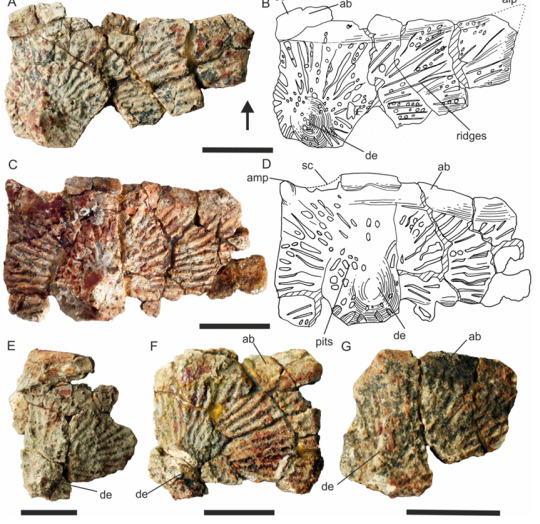
I'll be entirely honest. This was a lot more work to type out than anticipated, but admittedly also fairly rewarding. Hopefully you dear reader found it equally interesting, and hey, congrats on making it to the end.
#palaeoblr#paleontology#prehistory#croc#crocodile#long post#pseudosuchia#sutekhsuchus#argochampsa#peirosauridae#thalattosuchia#metriorhynchoidea#teleosauroidea#kuttysuchus#aetosauria#paralligator#leidyosuchus#cryodrakon#borealosuchus
142 notes
·
View notes
Text
#Paleostream 10/05/2025
here's today's #Paleostream flocking sketches!!! this was also my 100th flocking 🎊🥳🎊
today we sketched Attenborosaurus (happy birthday Sir. David Attenborough!!!), Dakosaurus, Etjosuchus, and Dibango volans

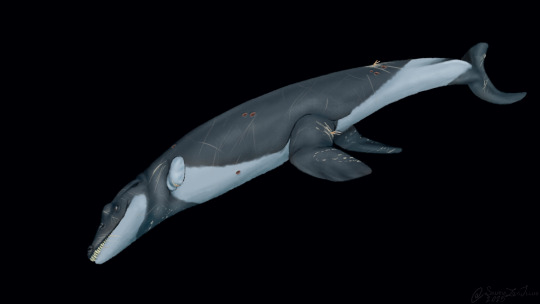
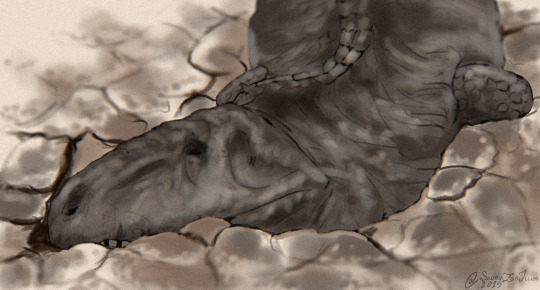

#Paleostream#sketch#sketches#paleoart#digital art#paleontology#digital artwork#artists on tumblr#palaeoart#digital illustration#sciart#id in alt text#paleoblr#palaeoblr#marine reptile#extinct marine reptile#plesiosauria#plesiosaur#pliosaur#david attenborough#Attenborosaurus#Turnersuchus#Pseudosuchia#pseudosuchian#Thalattosuchia#Metriorhynchidae#Dakosaurus#Etjosuchus#Dibango#Dibango volans
52 notes
·
View notes
Text
I apologize for such a long delay. I couldn't find the motivation to keep posting here. But, as I promised in my last post, here are three more drawings made for last year's scientific conference. :)

Front half of Dakosaurus andiniensis, massive metriorhynchid from Late Jurassic of Argentina. As with Cricosaurus, I based this reconstruction on metriorhynchid specimens with skin. Note the presence of speculative skin parasites, whose marks were founds in fossil skin. Also, there are salt glands in antorbital fenestra. This feature is based on this study: https://anatomypubs.onlinelibrary.wiley.com/doi/10.1002/ar.24678 BTW, some recons portray Dakosaurus with crocodile-like facial integument and some recons even have "lips"! I decided to diversify from these both options and did it with smooth streamlined skin.
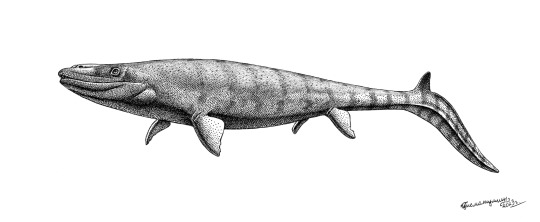
Prognathodon sp. reconstruction based on purportedly juvenile specimen with soft tissue outlines from Late Cretaceous of Jordan. This small individual was described in this paper: https://www.nature.com/articles/ncomms3423 Preserved skin impressions include silhouettes of the skin fringes of the flippers and the caudal fin. The caudal fin is quite small, but in adults it could be proportionally larger. This finding confirmed that mosasaurs converged with ichthyosaurs and metriorhynchids to develop a fish-like caudal fin.
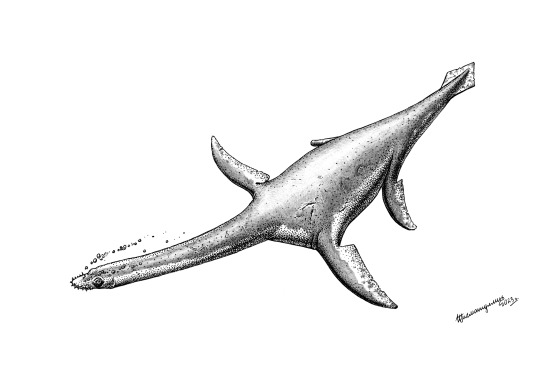
And finally, Seeleyosaurus guilelmiimperatoris (formerly species of Plesiosaurus), a microcleidid plesiosaur from Early Jurassic of Germany. Holotype of this species is almost complete specimens with some skin impressions including rhomboidal skin flap. Perhaps all plesiosaurs had caudal fins of one form or another. However, their orientation is controversial: many paleontologists are of the opinion that the fin was vertical, but others think it was horizontal.The arguments in favor of the second point of view are the rigidity of the chest, the flat and wide shape of the tail in the proximal part and the absence of bending in the distal part of the tail: https://www.researchgate.net/publication/339423536_Peculiarities_of_the_Structure_and_Locomotor_Function_of_the_Tail_in_Sauropterygia I decided to choose this version for reconstruction. Which of the scientists is closer to the truth, new findings will show. All of these drawings were done with black gel ink pen and black colored pencil with small additions of white gouache.
#dakosaurus andiniensis#dakosaurus#metriorhynchidae#thalattosuchia#prognathodon#mosasaur#seeleyosaurus#plesiosaurus#plesiosaur#sauropterygia#marine reptile#paleoart
27 notes
·
View notes
Text

An indeterminate crocodylomorph tooth, possibly a thalattosuchian from the Isalo III Formation in Ambondromamy, Madagascar. These primarily Jurassic aged crocodylomorphs are sometimes known as marine crocodiles or sea crocodiles, though not particularly related to true crocodilians.
#crocodylomorpha#fossils#paleontology#palaeontology#paleo#palaeo#thalattosuchia#jurassic#mesozoic#prehistoric#science#paleoblr#タラットスクス亜目#海ワニ#ワニ#化石#古生物学
5 notes
·
View notes
Text
I uploaded the data onto morphosource for this paper hehe
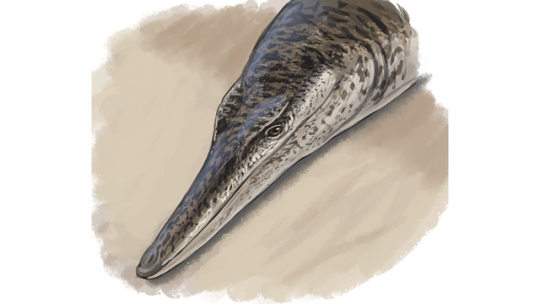
This ancient crocodile looked kind of like a dolphin
Enalioetes schroederi’s ���radically different’ body was scaleless, speedy, and lost to researchers for decades.
A set of 135 million-year-old fossils, once thought lost during World War II, are now accounted for and analyzed. According to a study published July 18 in the Journal of Systematic Paleontology, a team of international researchers from Germany and the UK has determined the “well preserved” skull and first neck vertebrae are from what they now call Enalioetes schroederi. But while paleontologists now know they belong to a newly discovered species of ancient marine crocodile, these creatures likely looked more like dolphins than reptiles...
Read more:
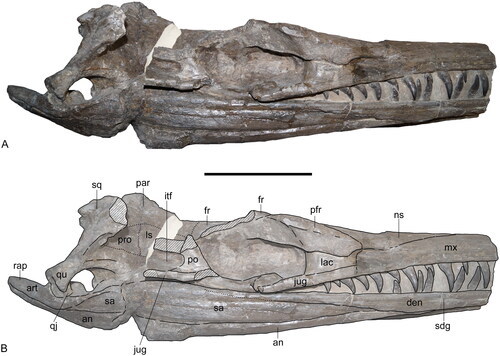
https://www.popsci.com/science/ancient-crocodile-dolphin/
382 notes
·
View notes
Text
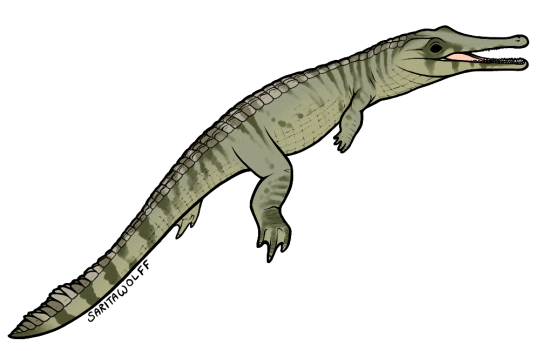
Patreon request for @/rome.and.stuff (Instagram handle) - Turnersuchus hingleyae
Described just last year, the Early Jurassic Turnersuchus is the most basal known member of the thalattosuchians: sea-dwelling crocodylomorphs. It existed before the two major thalattosuchian groups, the paddle-limbed Metriorhynchoidea and the long-snouted Teleosauroidea, split, and it may be the ancestor of both. While only parts of the skull are known, its shape suggests a narrow snout that was not as long as that of later thalattosuchians. Only one osteoderm is known, and it is oval with a slight keel down the middle, believed to have been attached to the tail. As humble as this small pseudosuchian was, it helped us fill in the major gaps of our understanding of thalattosuchia, and finally gave us an idea of their origin. Previously, all we knew was that the highly-derived metriorhynchoids and the more crocodile-like teleosauroids were related, lived alongside each other, and seemingly appeared in the Jurassic. While not as well known as the icthyosaurs, plesiosaurs, and mosasaurs, thalattosuchians were very successful sea crocodylomorphs until around the Early Cretaceous, and they owe their success to this little pseudosuchian who decided to return to the sea.
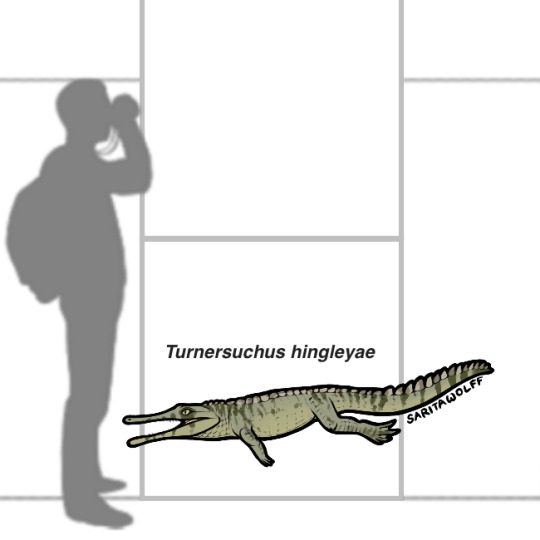
Found in the Charmouth Mudstone Formation of England, Turnersuchus would have lived alongside a variety of ammonites like Phricodoceras and Gemmellaroceras, as well as icthyosaurs like Leptonectes. It likely fed on the small fish that lived here. As it was not as highly adapted for ocean life as its descendants, it may have spent some time basking on land, where it could have come across early dimorphodontid pterosaurs and the armored Scelidosaurus.
#my art#Turnersuchus hingleyae#Turnersuchus#Thalattosuchians#crocodylomorphs#pseudosuchians#archosaurs#archosauromorphs#reptiles#SaritaDrawsPalaeo#Charmouth Mudstone Formation#Early Jurassic#England
7 notes
·
View notes
Text
Description and phylogenetic relationships of a new species of Torvoneustes (Crocodylomorpha, Thalattosuchia) from the Kimmeridgian of Switzerland
Published 19th July 2023
A new metriorhynchid from the Kimmeridgian of Porrentruyi Switzerland based on a relatively complete disarticulated skeleton, Torvoneustes jurensis.
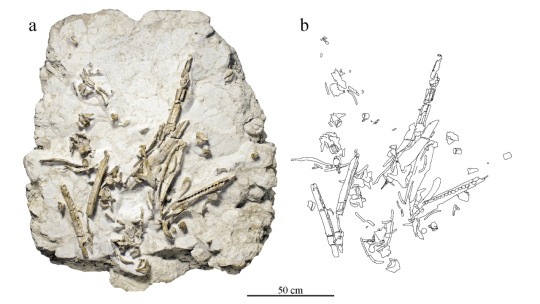
Torvoneustes jurensis holotype
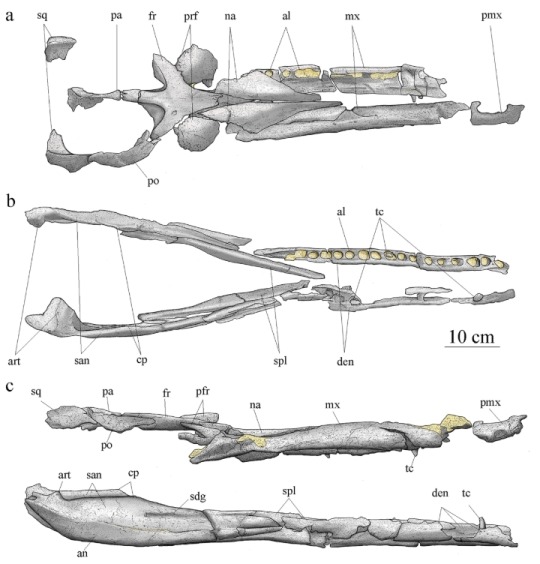
Artist illustration of jaw and mandible

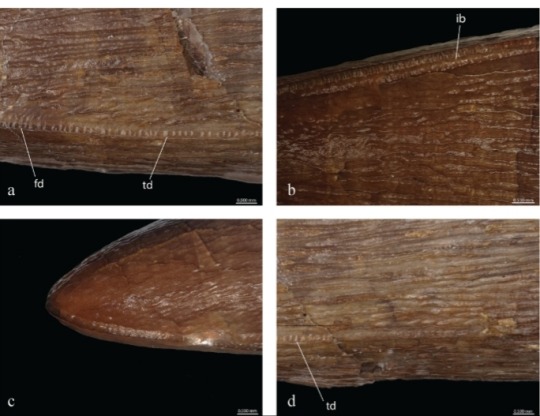
Torvoneustes jurensis teeth

Artist reconstruction of Torvoneustes jurensis, by SDSO.
Source:
9 notes
·
View notes
Text

Machimosaurus adalah salah satu genus Teleosauridae yang sudah punah. Hewan ini masih satu keluarga dengan buaya, dan berasal dari zaman Jura Akhir (Kimmeridgian dan Tithonian) dan Kapur Awal.[2][3] Tipe spesies Machimosaurus hugii ditemukan di Swiss. Fosil lainya juga ditemukan di Inggris, Prancis, Jerman, Portugal, dan Tunisia.[2][4][5] Machimosaurus bukan saja teleosaurid dan thalattosuchia terbesar, dengan panjang tubuh mencapai 9.6 meter (panjang tengkorak 155 cm), ia merupakan buaya terbesar dari zaman Jurasik.[2][3][4]
0 notes
Text
Two more croc-line archosaurs to dig into with this one and both are super fascinating.
Obviously the star of this piece is our friend in the foreground, Plesiosuchus manselii, the largest of the fully marine metriorhynchids (the skull of which being the first one shown in the image to the right, taken from Young et al. 2012)
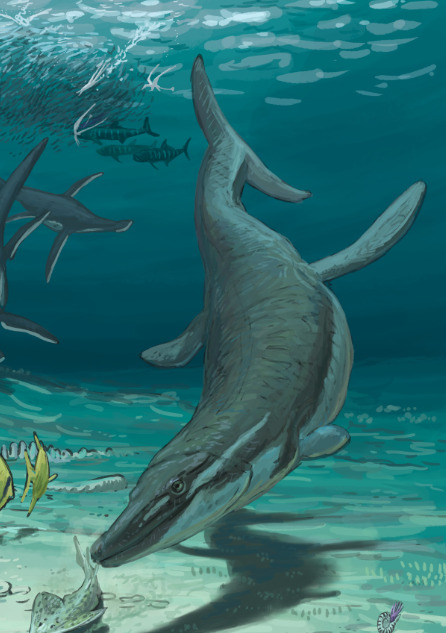
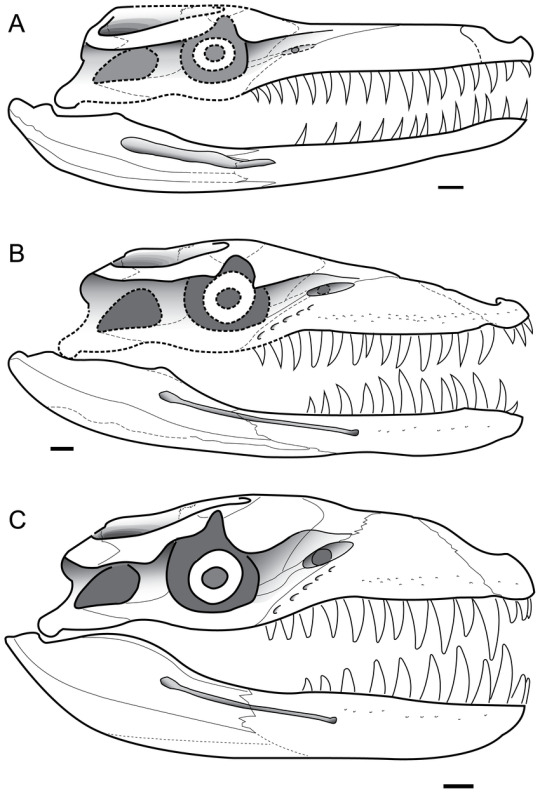
More broadly speaking, metriorhynchids are a fascinating group of early croc-relatives that stand out for having returned completely back into the water, developing a fluked tail, tiny little reduced forelimps, flipper like hindlimbs and smooth skin entirely lacking in the osteoderm armour we so strongly associate with pseudosuchians.
Plesiosuchus specifically is the largest of them. Close to 7 meters in length, it's basically in the same range as Liopleurodon (although smaller than several of the pliosaurs we know from the Kimmeridge Clay like that very decorative skeleton). Plesiosuchus actually wasn't the only metriorhynchid from the formation either. We also know of the small Cricosaurus, the name-giving Metriorhynchus and most interestingly the large-bodied Dakosaurus and Torvoneustes, which were likely to reach lengths of 4.5 to 4.7 meters respectively. At least with metriorhynchids this diversity can be explained in the different animals having very different preferences. Torvoneustes is interpreted as a durophage, feeding on hard-shelled prey. Dakosaurus is characterized by slicing dentition, potentially able to cut apart large prey with tooth wear possibly suggesting sharks or suction feeding habits. Plesiosaurus meanwhile would be able to take on large prey simply due to its great size and large gape but may have been limited by the size of its own head.
The other marine "croc" in the image is Bathysuchus, which may be described as a cousin to the metriorhynchids.


Remember Machimosaurus from the Guimarota locality that Josch drew a few weeks back? Yeah its related to that one. A teleosauroid to be precise, which are the sister group to metriorhynchoids and appear much more croc-like in their appearance despite still being a long way off from crocodiles in the strict sense. Teleosauroids may appear like what you'd think of as basal to metriorhynchoids, but they simply did their own thing after diverging, thus retaining this more ancestral bauplan with more developed limbs, more croc-like skulls and maintaining their armour plating (keep that in mind).
Bathysuchus is kind of a weird one tho. Why? Because from what we can tell Bathysuchus seems to have tried to become more like its metriorhynchoid cousins. It's known from deeper waters, its osteoderms were much more reduced and if the closely related Aelodon is anything to go from then its quite likely that this guy also started reducing the size of its forelimbs. In short, adaptations to a more pelagic lifestyle that moves away from the coastal habitat other teleosauroids seem to have preferred. Who knows, maybe its possible that in some other timeline these guys might have become something akin to metriorhynchoids like what happened with mosasaurs.
Unlike metriorhynchoids, teleosauroids were way less common in the Kimmeridge Clay, hell, to my knowledge Bathysuchus is the only one of them, a pretender among the other pelagic pseudosuchians.
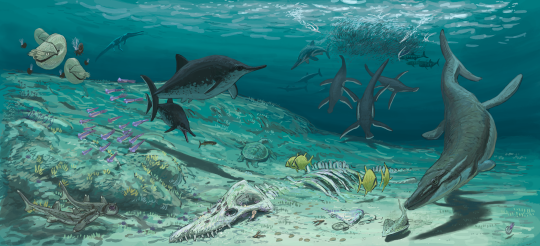
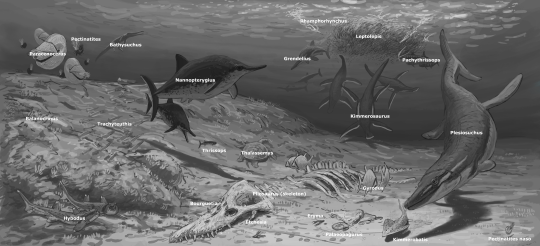
Result from the Kimmeridge Clay #paleostream!
We were only able to scratch the surface, but I think you get the idea ;)
#bathysuchus#plesiosuchus#kimmeridge clay#crocs#pseudosuchia#crocodile#metriorhynchidae#metriorhynchoidea#teleosauroidea#thalattosuchia#crocodyliform#jurassic#marine croc#paleostream#palaeoblr
599 notes
·
View notes
Text
Fossil Crocs of 2023
2023 has been a year with its ups and downs, but one consistent thing has been its fossil crocs at least, giving us another interesting variety of species and genera not known before. Like last year, I'll go down each of them (including phytosaurs) and give you some key notes. And since I've done my best to make individual posts for them I'll link those when available. I'll also try to give translations where possible, but do note that sometimes I might switch around a word due to it just sounding awkward otherwise.
Scolotosuchus
Starting us off is Scolotosuchus basileus ("royal scythian crocodile"), a basal, rauisuchian-like animal from the early stages of the Triassic. An animal roughly 3 meters long, it is primarily known from vertebrae and some other material, which however does have interesting implications. Based on the anatomy of the vertebrae, it has been speculated that Scolotosuchus performed a lot of rapid movement of the neck, presumably while hunting. Furthermore, it might be that Scolotosuchus lacked osteoderms, instead having developed a bracing system for its body much more like that of dinosaurs and mammals. Artwork by @knuppitalism-with-ue (he'll pop up quite a lot)
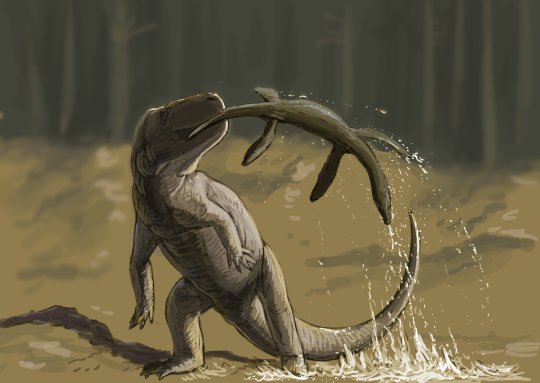
Colossosuchus
Fast forward to the Late Triassic, the hayday of early Pseudosuchians, and we find our first phytosaur of the list. Colossosuchus techniensis ("colossal crocodile of the Indian Institute of Technology") was an enormous animal from India's Tiki Formation. This one is known from undisputably better material, perhaps some of the best on this list as we have an entire bone bed of these guys, possibly representing a mass death site. Size estimates of the large specimens generally range from 6 to 9 meters in length, also making it the largest animal of this list, with the authors favoring an estimated 8 meters for the largest individual. Of course this is all subject to change, as we don't know the precise proportions (the downside of a bone bed is that all the bones are kinda jumbled together and god knows what belongs to what). Artwork by Joschua Knüppe again, a female being courted by an overconfident and confused Volcanosuchus (told you so)
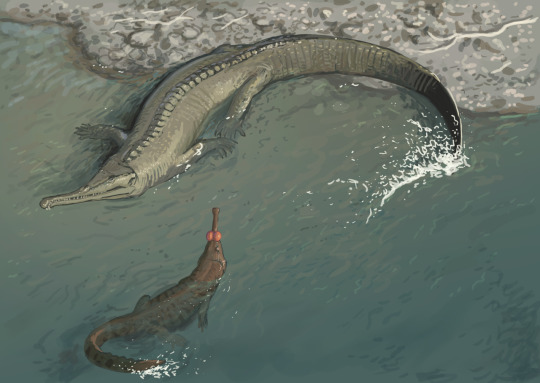
Kryphioparma
Ok I won't bother you with this one too much. Kryphioparma caerula ("blue mysterious shield") is an aetosaur from the Late Triassic Chinle Formation of Arizona. Now aetosaurs are cool of course, but the thing is that Kryphioparma is known from exclusively osteoderms, their large armour plates. While thats valid, its also not really exciting (as you could have guessed from the absolute lack of artwork). Best I can say is that it coexisted with a bunch of other aetosaurs, which surely would have been a sight to see back in the day.
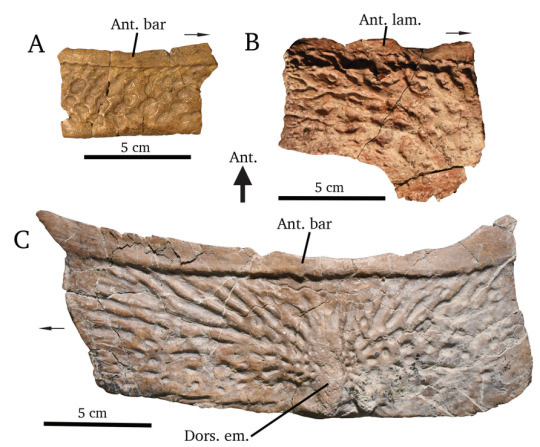
Venkatasuchus
Now Venkatasuchus armatum ("Venkata's armoured crocodile") is in a similar boat. This Indian aetosaur too is only known from osteoderms, tho at least a lot more of them that were found together, meaning we got a much better idea of its shape. There are some interesting implications it has on paleogeography and how different animal groups spread across Pangea, but that's probably beyond the scope of this post. There is at least some art of it tho, including one piece by Joschua featuring Jaklapallisaurus, an early sauropodomorph.
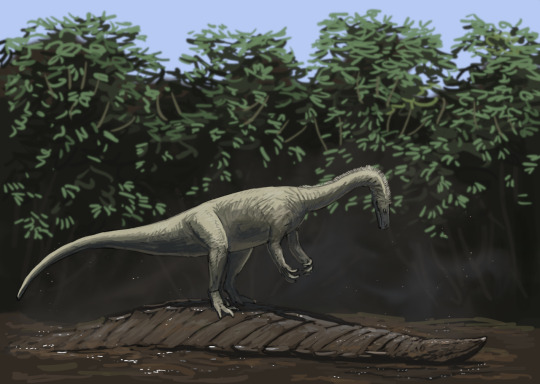
Mystriosuchus alleroq
Now we got our first new species of a preexisting genus. While I did my best to make posts on new genera, which typically went hand in hand with their respective wikipedia pages, species are a different matter since they'd require me to overhaul and research the whole genus. Which for Mystriosuchus would go all the way back to 1896.
Anyhow, Mystriosuchus alleroq ("jawbone spoon crocodile") is the newest in a long line of Mystriosuchus species and has been recovered from western Greenland of all places. Like Colossosuchus it is known from multiple individuals, at least four in fact, And like Venkatasuchus, it appears to have wideraning implications for the spread of archosaurs during the Triassic. Oh look its Josch's art again, neat.
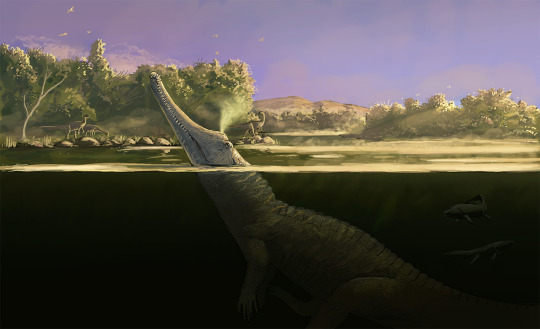
Jupijkam
The final phytosaur and the final Triassic taxon of the year, Jupijkam paleofluvialis ("horned serpent of ancient rivers") was recovered from Nova Scotia Canada and represents one of the northernmost phytosaurs (alongside obviously our friend Mystriosuchus alleroq above). It is far less complete than the other phytosaurs I covered so far, but still nothing to scoff at. It's also one of the youngest known phytosaurs, possibly having lived during the last stage of the Triassic. There's no art but here's an image of its snout from the original paper.
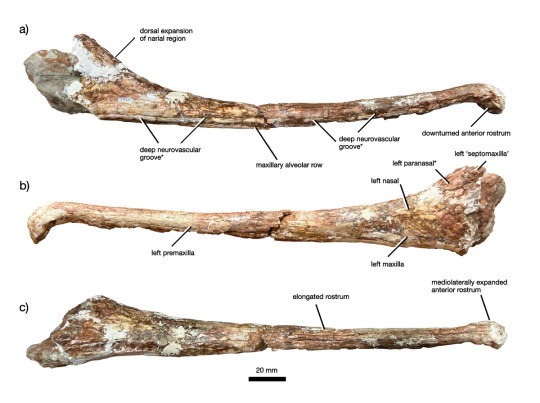
Turnersuchus
And with this we have reached the Jurassic and somewhat of a double feature. Ordering these via chronology makes this almost like storytelling. Turnersuchus hingleyae ("Hingley's and Turner's crocodile") is the oldest and basalmost named thalattosuchian, a group of crocodylomorphs that took to the seas. As such it shows a mosaic of features, already having begun to reduce its limbs, having a moderately long snout and still bearing osteoderms, which some of its descendents would come to lose. Turnersuchus dates to the Pliensbachian, a stage of the early Jurassic, tho the paper mentions how its not likely to hold its title as oldest member of its group for long as even older material has been discovered and is awaiting publication. Artwork by Júlia d’Oliveira and Joschua Knüppe
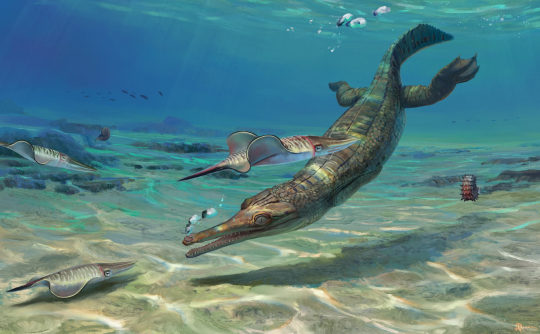
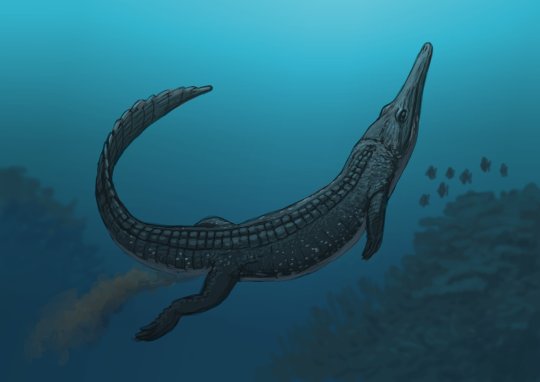
Torvoneustes jurensis
While Turnersuchus gives us a glimpse at what the earliest thalattosuchians were like, Torvoneustes jurensis ("savage swimmer of the Jura Mountains") represents them at one of their most derived. At 4 meters long, it must have been an impressive creature, entirely smooth and lacking osteoderms, highly reduced arms and a tail fluke to boot. There are some interesting features, as unlike other species of Torvoneustes, this one does not appear to have been as durophagous, instead appearing to be more of a generalist. It's the last Jurassic croc of the year and practically lived at the opposite end of this time period relative to our previous thalattosuchian, during the Kimmeridgian. Artwork by Sophie De Sousa Oliveira, not to be confused with Jùlia who drew Turnersuchus.
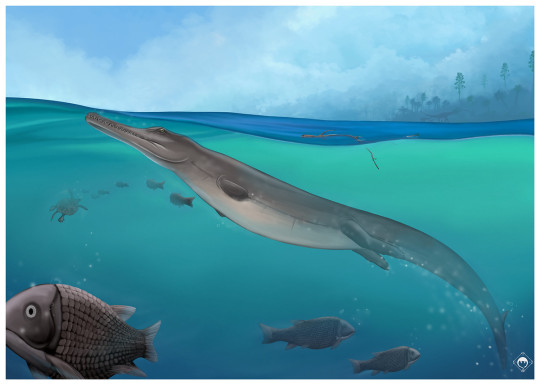
Comahuesuchus bonapartei
From marine to terrestrial, Comahuesuchus bonapartei is a member of the Notosuchia, land-dwelling cousins to the Neosuchia. This new species is known from the Cretaceous of Argentina and was described on the basis of a lower jaw, which differs from the previously described species of Comahuesuchus by the fact that the teeth are situated in individual sockets. Its jaws were short and wide, being described as U-shaped, giving it a somewhat pug-nosed appearance. In case you're wondering why I don't have the translation of the name thats because I can't access Bonaparte's first paper, so all I can say is that the new species is named after famed Argentinian paleontologist Jóse Fernando Bonaparte. Artwork by I mean you probably guessed it, its Josch again.

Aphaurosuchus kaiju
I have some mixed feelings on Aphaurosuchus kaiju ("powerless kaiju crocodile"), not just because I have to rewrite its genus wikipedia page that I am no longer happy with. No, Aphaurosuchus is a great genus in my opinion, given the complete nature of the holotype. But I do think that the species name of this second form is a bit of an exaggeration, seeing as it is to my knowledge not that exceptionally big. So why name it kaiju other than to sound cool? I also think it just kinda becoms funny when you consider the meaning of the genus name. Anyhow, it does look pretty mean, but thats to be expected from a baurusuchid. It lived during the Late Cretaceous in Brazil and the phylogenetic analysis that accompanied its description had some interesting implications that I'm curious to see tackled in the future. Other than that it's just another baurusuchid from a place crawling with baurusuchids, which tbh is pretty cool itself but doesn't really help make it stand out. Arwork by Paula Zeinner
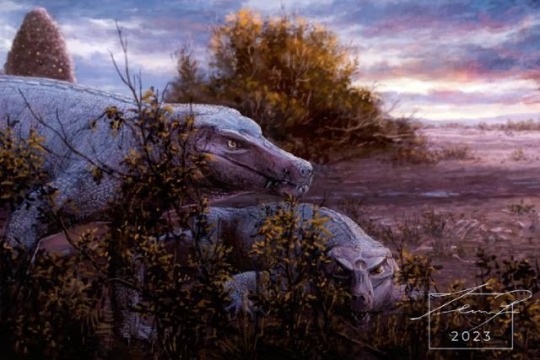
Dentaneosuchus
It is the middle Eocene. France is entirely occupied by mammals. Well, not entirely... One indomitable reptile still holds out against the invaders. Yes, I am of course talking about Dentaneosuchus ("frightfull crocodile"), the titan of the Eocene, the terror of the jungle. Easily among the most exciting finds, this animal was an enormous sebecid previously thought to be a member of the genus Iberosuchus, but recent research not only shows its distinct but enormous. With a lower jaw around 90 cm long, it rivals even the famed Barinasuchus of Miocene South America. The total body lenght is of course a matter of debate given how little we know about sebecid proportions, with the paper lowballing it at 3 to 4 meters and I personally recovering something more akin to 5 meters. Regardless of the specifics, this would make it easily one of the top predators of its time, tho sadly this was not meant to last. It was among the last non-mammalian apex predators of Europe, before climate change and competition from mammals eventually drove them to extinction. Arwork by Joschua Knüppe and @mariolanzas
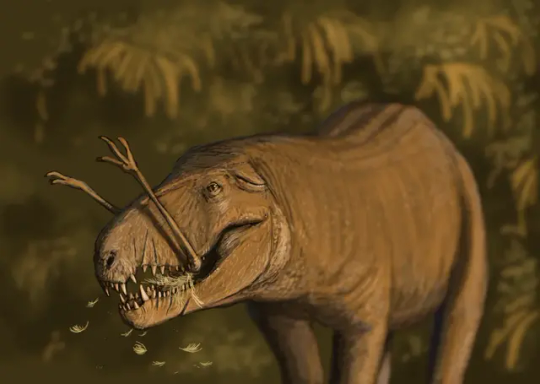

Baru iylwenpeny
Our last three entries were all members of the Notosuchia, the terrestrial crocodiles that existed from the Jurassic to the Miocene, so lets jump to the other major group of the time, the Neosuchians, specifically their most recent branch, the Crocodilians. Yes finally we are getting to crocs in the stricter sense.
Baru iylwenpeny ("divine crocodile thats good at hunting") is an animal we also knew for a while under the informal name Alcoota Baru based on where it was found. This year I spent a lot of time writing in the Mekosuchinae, Australasian crocodiles of the Cenozoic and just when I had finished the page for Baru, this guy got published. It's the largest, most robust and most recent member of the genus. Good at hunting is a good choice for the species name, as this animal was over 4 meters long with a head commonly likened to a cleaver and a hunting style speculated to consist of inflicting a lot of trauma on its prey with its massive teeth. I could gush about Baru for ages, but thats the important parts. It lived in central Australia during the Miocene only 8 million years ago. Artwork by the incredible @manusuchus
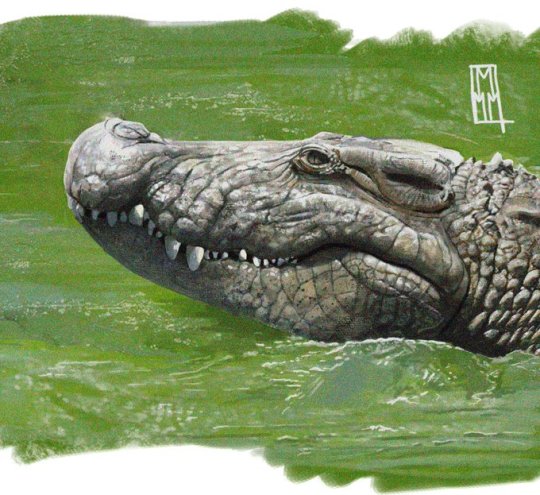
Antecrocodylus
Now for the last crocodilian described this year and one I remised to make a dedicated post for due to time constraints (I had a busy few months). Antecrocodylus chiangmuanensis ("before Crocodylus from Chiang Muan") is a close relative of the modern dwarf and true crocodiles from the Miocene of Thailand. It is only known from the back of the skull and an associated lower jaw, but it serves to highlight how little we know about the crocodiless of eastern Asia during the Miocene, which is a shame given that this region is crucial to deciphering where true crocodiles originated.

Alligator munensis
And our final taxon is Alligator munensis ("Mun river alligator"), which, obviously, is a member of the modern genus Alligator and thus most closely related to the still extant Chinese and American Alligator. Likely having been split from its Chinese relatives when the Tibetan plateau was lifted up, this species lived during the middle Pleistocene in Thailand and may have survived until the Holocene. It's head was short and robust and its teeth globular, which could indicate that it fed on hard-shelled prey like clams and snails. It was also small, likely not much bigger than 1.5 meters. Artwork by Joschua Knüppe
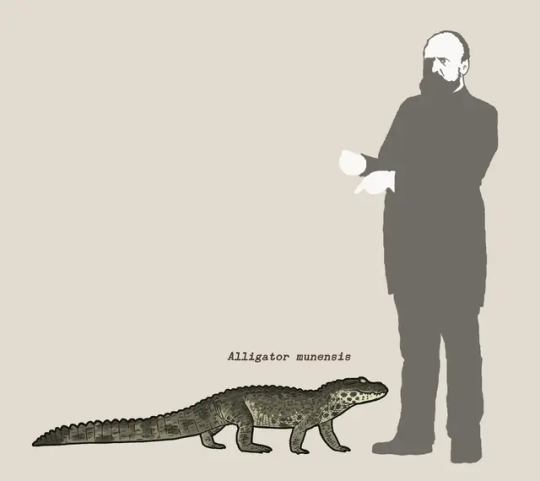
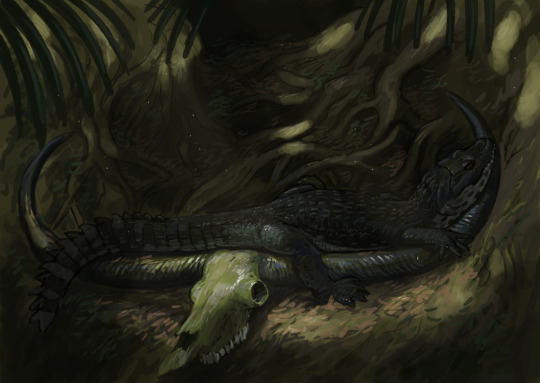
And that should be all of them, all new species and genera of Pseudosuchians described this past year. It's once again been fun to look back and I hope that you find them just as interesting as I do. Lets hope that 2024 will bring equally fascinating discoveries.
#alligator munensis#alligator#croc#crocodile#pseudosuchia#notosuchia#crocodilia#crocodylus#antecrocodylus#thalattosuchia#torvoneustes#paleontologoy#torvoneustes jurensis#turnersuchus#comahuesuchus#aphaurosuchus#aphaurosuchus kaiju#dentaneosuchus#jupijkam#colossosuchus#palaeoblr#prehistory#kryphioparma#venkatasuchus#mystriosuchus#scolotosuchus#baru#baru iylwenpeny#science
273 notes
·
View notes
Photo



It's been a while since I last showed off some of these, but here's some more commission work I've done for PBS Eons:
The metriorhynchid marine crocodilians Aggiosaurus and Cricosaurus, from "When Crocs Thrived in the Seas" https://www.youtube.com/watch?v=vgqs_9BBX10
And… what's this?

A familiar Scutellosaurus makes an appearance in a recently-published children's dinosaur book!
———
Nix Illustration | Tumblr | Twitter | Patreon
#science illustration#paleontology#paleoart#palaeoblr#pbs eons#aggiosaurus#cricosaurus#metriorhynchidae#thalattosuchia#crocodylomorpha#crocodilian#pseudosuchia#stem-croc#art#scutellosaurus#published artwork
331 notes
·
View notes
Text
My second paper is out!
I'm second author rather than first on this one, but if you have any questions on it feel free to reach out! It's about the grooves we found on the palates of fossil crocodylomorph skulls! These palatal grooves (PG in the thumbnail image) are found in Thalattosuchians, crocodylomophs adapted for live at sea!
34 notes
·
View notes
Text
Croc sweep. How can you not love them, metriorhynchids in particular. I mean just look at those baby hands, they are ADORABLE. @knuppitalism-with-ue for scale, photo by Sven Sachs

obviously I can't include everything. Rip to the various groups I was forced to leave out, including Mesosaurs, my beloveds.
491 notes
·
View notes
Text

A worn crocodylomorph tooth of a Dakosaurus maximus from the Kimmeridge Clay in the Wicklesham Pit in Faringdon, Oxfordshire, England. This species of marine croc was likely fully aquatic and hunted plesiosaurs and ichthyosaurs. The heavy wear seen in this tooth is due to these Jurassic fossils from the Kimmeridge Clay being reworked into the overlaying Lower Cretaceous aged Faringdon Sand.
#crocodylomorpha#fossils#paleontology#palaeontology#paleo#palaeo#dakosaurus#metriorhynchidae#thalattosuchia#jurassic#mesozoic#prehistoric#science#paleoblr#ダコサウルス#メトリオリンクス科#タラットスクス亜目#海ワニ#ワニ#化石#古生物学
18 notes
·
View notes
Text

From Dinosauriërs, written by Peter Klepsch and published in the 80s. Illustrated by Thomas Thiemeyer.
(via)
#prehistoric#prehistoric reptiles#prehistoric marine life#icthyosaurs#thalattosuchia#Thomas Thiemeyer
88 notes
·
View notes